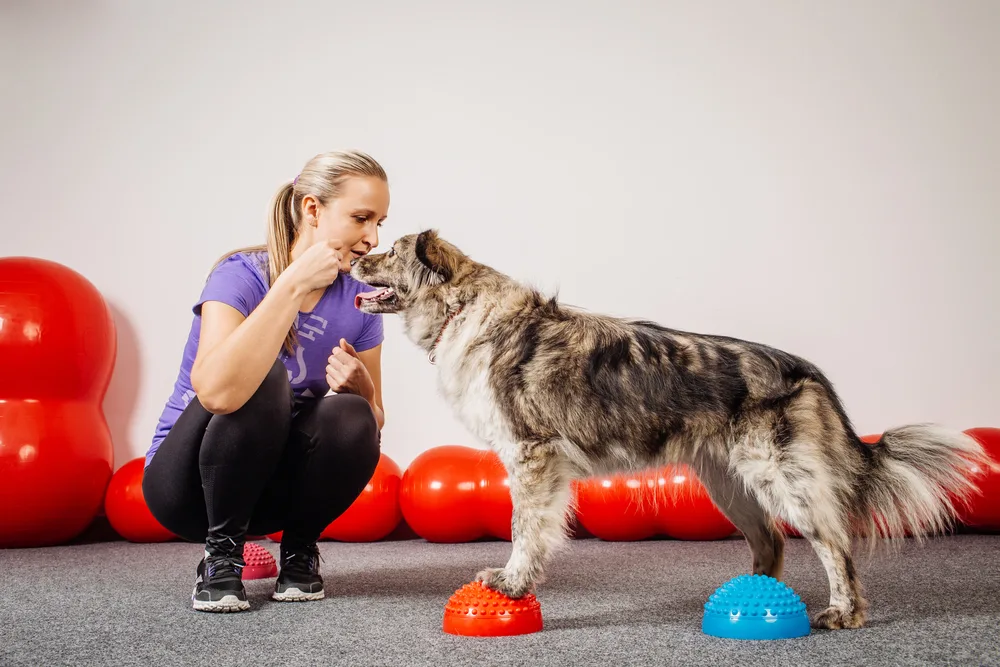Do you love dogs, or dream of working as a dog trainer? If so, then our 100-hr dog training course is perfect for you. You will learn about canine psychology, senses, dog training, dog obedience, solving behavioural disorders, and much more in this online course. This course is suitable for students, dog owners, dog and animal professionals, and anyone wanting to learn more about dogs and their behaviour and training.
- 100 hours
- Self Paced
- Online Study
- 1-on-1 Tutor Support
“This is an interesting course covering canine historical development, normal behaviours, actions, reactions, interactions etc. Then it looks at behaviours that are interpreted as “unwanted” or abnormal and the influences of disease, the environment and surrounding people on developing behavioural issues. It is basically an introductory course that can be a good start to a career in dog training. But you will be the person to determine how much you will get out of the course. There are beautiful websites and sources to extend your research e.g. if you are doing some of our case studies to look at problem behaviour of a specific dog/patient and you have to suggest an approach as his behaviourist. We only ask for one possible approach or solution to the problem behaviour, but you are welcome to research and submit more than one approach. Just remember, there is no easy fix that works on all.
I find that anxiety is the one major component of most of the behavioural issues that I see in clinic. And most people cannot even pick-up or read the signs when their pet is fearful, or anxious. So a lot of behavioural work is not only working with the poor animal, but also education of the owners. Theory does give you the background but to really be a good behaviourist, you need to be an observer. So a good approach would be to combine our course with hands-on work e.g be a dog-walker, pet-sitter, help at puppy-classes, do dog grooming, volunteer etc. This would give you so much opportunity to experience different personalities, interactions, wrong approaches by owners etc. And it would show your commitment and passion on your CV.
Both Karen and I (as the two animal science tutors) are vets and we are passionate about understanding animals, their behaviour, their needs etc. I do believe that with having more knowledge anyone can make a difference. ”
Dr. Karin Dreyer-Haasbroek B.V.S. M.Sc
Read more here on Communicating with your dog by Dr Karin
Why Study Dog Psychology?
An understanding of canine psychology and behaviour is vitally important for anyone who works with dogs or keeps them as a companion animal. Understanding how the domesticated dog has developed anatomically and physiologically from its wild counterpart, the wolf, will helps us to understand behaviours commonly seen in today’s domesticated dog and therefore allows us to provide an environment in which the dog remains a happy and healthy companion.
Its important to remember that many dogs display behavioural problems or ‘unwanted behaviour’ at various stages in their lives. Often, an unwanted behaviour is merely a symptom of an underlying problem (either mental or physical) and the unwanted behaviour that is displayed is the dog’s way of coping with the problem. It is important to remember that the behaviour may be ‘unwanted’ in human terms only; it is a natural response for a dog to bark when the door-bell rings or to dig a hole in the garden. Understanding dog psychology will help make sense of the dogs behaviour.
What You Will Do
- Describe how canine animals think and discuss the relevance of understanding canine psychology to people.
- Explain how canine animals communicate and formulate an understanding of possible ways that a human may communicate with a dog.
- Understand behaviours that are natural and predictable in canines and learn to recognise and understand signals that dogs give.
- Explain how dogs develop behavioural characteristics throughout stages of their life.
- Describe commonly occurring behavioural problems in dogs.
- Develop a program for training a new pet dog when it is brought into a household.
- Explain how to train a dog to perform predetermined actions upon command.
- Describe how the movement of dogs can be controlled, both through training and other methods.
- Describe how dogs can be trained to perform tasks required as a working dog, including a sheep dog, tracking dog, blind dog or substance detection dog.
There are 9 lessons in this course:
1. Nature and Scope of Canine Psychology
-
- A brief history of the canine evolution
- Self-domestication
- Canine industries
2. Canine Senses
-
- Understanding canine communication
- Sight
- Body Language
- Smell
- Sound
- Elimination Postures
3. Understanding Natural Canine Behaviour
-
- Social Structure
- Social Behaviour
- Aggression
- Clinical Problems
- Biological Rhythms
- Sleep
- Sexual Behaviour
- Maternal Behaviour
- Parturition
- Suckling and Weaning
- Eating and Drinking
4. Canine Behavioural Development
-
- Nature or Nuture
- Sensitive Periods
- Neurological Development
- Canine Temperament Testing
- How Breeds Differ
5. Canine Behavioural Disorders
-
- Attention Seeking Behaviour
- Excessive barking
- Chewing
- Running away
- Chasing moving objects
- Begging
- Digging
- Separation anxiety
- Agression
- Phobias
- Excessive compulsive disorders
- Cognitive Dysfunction
- Calming a dog
6. Basic Dog Training
-
- Forming habits
- Conditioning
- Classical Conditioning
- Operant Conditioning
- Socialisation
- House training
- The use of visual signals
- The use of voice commands
- The use of training aids
7. Dog Obedience Training
-
- Practical Training Techniques
- Recall
- Sit
- Stand
- Drop
- Leave
- Down
- Stay
- Heel
- Seek
- Retrieve
- Bark on Signal
8. Controlling a Dogs Movement
-
- Territorial nature of dogs
- Fencing
- Dog doors
- Kennels
- Exercise requirements
- Socialisation requirments
- Walking on a lead/leash
- Electronic barriers
- Microchips
- Pet Registration and Licensing
- Controlling Killing Wildlife
9. Training Working Dogs
-
- Training for scent discrimination or substance detection
- Training for retrieving
- Guarding
- Hearing dogs
- Hearding
- Tracking
- Controlling attacks on animals and people

